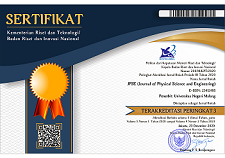Hydrocarbon Mapping on Reservoir Carbonate Using AVO Inversion Method
Abstract
Amplitude Versus Offset (AVO) inversion has been applied for reservoir analysis focused on the horizon carbonate Peutu and Belumai. Simultaneous inversion analysis is used to determine gas anomaly inside carbonate-rocks and it’s spread laterally around target zones. It is based on the fact that small Vpand Vs value changes are going to show the better anomaly to identify reservoir fluid content. The AVO inversion method applies angle gather data as the input and then it is inverted to produce P impedance (Zp) and S impedance (Zs). Zp and Zs are derived to produce Lambda-Rho and Mu-Rho that are sensitive to fluid and lithology. Value of Mu-Rho between 44–65 Gpa gr/cc while value of Lambda-Rho smaller than 10 Gpa gr/cc (for carbonate-rock filled by fluid). This research found that Lambda-Rho is the best parameter to show the existence of hydrocarbon in the case of gas. While Mu-Rho is the best parameter to show the differences in lithology.
Keywords
Full Text:
PDFReferences
T. Tsuji et al., “Reservoir characterization for site selection in the Gundih CCS project, Indonesia,” Energy Procedia, vol. 63, pp. 6335–6343, 2014.
N. A. Pambudi, “Geothermal power generation in Indonesia, a country within the ring of fire: Current status, future development and policy,” Renewable and Sustainable Energy Rev., vol. 81, pp. 2893–2901, 2018.
S. M. Bina, S. Jalilinasrabady, H. Fujii, and N. A. Pambudi “Classification of geothermal resources in Indonesia by applying exergy concept,” Renewable and Sustainable Energy Rev., vol. 93, pp. 499–506, 2018.
A. Hidayatno, A. R. Destyanto, and C. A. Hulu, “Industry 4.0 technology implementation impact to industrial sustainable energy in Indonesia: A model conceptualization,” Energy Procedia, vol. 156, pp. 227–233, 2019.
R. Atmadibrata, D. Muslim, R. F. Hirnawan, and A. Abdurrokhim, “Characteristics of Arun carbonate reservoir and its implication to optimize the most potential gas resource zone in Arun gas field, Aceh, Indonesia,” Indones. J. Geosci., vol. 6, no. 2, pp. 209–222, 2019.
H. H. Al-Attar, M. Y. Mahmoud, A. Y. Zekri, R. Almehaideb, and M. Ghannam, “Low-salinity flooding in a selected carbonate reservoir: Experimental approach,” J. Pet. Explor. Prod. Technol., vol. 3, no. 2, pp. 139–149, 2013.
M. A. Sebtosheikh and A. Salehi, “Lithology prediction by support vector classifiers using inverted seismic attributes data and petrophysical logs as a new approach and investigation of training data set size effect on its performance in a heterogeneous carbonate reservoir,” J. Pet. Sci. Eng., vol. 134, pp. 143–149, 2015.
B. Goodway et al., “Combined microseismic and 4D to calibrate and confirm surface 3D azimuthal AVO/LMR predictions of completions performance and well production in the Horn River gas shales of NEBC,” The Leading Edge, vol. 31, no. 12, pp. 1502–1511, 2012.
W. J. Yoon and M. Farfour, “Spectral decomposition aids AVO analysis in reservoir characterization: A case study of Blackfoot field, Alberta, Canada,” Comp. Geosci., vol. 46, pp. 60–65, 2012.
B. S. Ajanaku and O. J. Akintorinwa, “Determination of gas reservoir (s) using AVO inversion within “XY” field offshore Niger Delta,” Pet. Res., vol. 4, no. 1, pp. 52–58, 2019.
S. A. Negm, M. H. Khalil, and A. Bakr, “Gas prediction through the LMR method using post-stack inversion and multi-attributes, F3 cube, North Sea, Netherlands,” Arabian J. Geosci., vol. 13, no. 14, pp. 1–12, 2020.
H. Budiman, M. Y. N. Khakim, and A. K. Affandi, “Analysis of AVO and seismic inversion for reservoir characterization (case study: EP field, South Sumatera Basin),” J. Eng. Sci. Res., vol. 2, no. 1, pp. 5–9, 2020.
P. Khalid and S. Ghazi, “Discrimination of fizz water and gas reservoir by AVO analysis: A modified approach,” Acta Geodaetica et Geophysica, vol. 48, no. 3, pp. 347–361, 2013.
A. Gisolf, “Parameterisation for reservoir oriented AVO inversion,” in 78th EAGE Conf. Exhibit. 2016, pp. 1–5, 2016.
L. P. de-Figueiredo et al., “Bayesian seismic inversion based on rock-physics prior modeling for the joint estimation of acoustic impedance, porosity and lithofacies,” J. Comp. Phys., vol. 336, pp. 128–142, 2017.
S. Bhattacharya, T. R. Carr, and M. Pal, “Comparison of supervised and unsupervised approaches for mudstone lithofacies classification: Case studies from the Bakken and Mahantango-Marcellus Shale, USA,” J. Natural Gas Sci. Eng., vol. 33, pp. 1119–1133, 2016.
C. Sayers, L. den-Boer, S. Dasgupta, and B. Goodway, “Anisotropy estimate for the Horn River Basin from sonic logs in vertical and deviated wells,” The Leading Edge, vol. 34, no. 3, pp. 296–306, 2015.
T. Azeem et al., “An application of seismic attributes analysis for mapping of gas bearing sand zones in the sawan gas field, Pakistan,” Acta Geodaetica et Geophysica, vol. 51, no. 4, pp. 723–744, 2016.
N. Ahmed, P. Khalid, S. Ghazi, and A. W. Anwar, “AVO forward modeling and attributes analysis for fluid’s identification: a case study,” Acta Geodaetica et Geophysica, vol. 50, no. 4, pp. 377–390, 2015.
P. Khalid, N. Ahmed, A. Mahmood, and M. A. Saleem, “An integrated seismic interpretation and rock physics attribute analysis for pore fluid discrimination,” Arabian J. Sci. Eng., vol. 41, no. 1, pp. 191–200, 2016.
A. Garg and D. J. Verschuur, “From surface seismic data to reservoir elastic parameters using a full-wavefield redatuming approach,” Geophys. J. Int., vol. 221, no. 1, pp. 115–128, 2020.
S. Bhattacharya and S. Mishra, “Applications of machine learning for facies and fracture prediction using Bayesian Network Theory and Random Forest: Case studies from the Appalachian basin, USA,” J. Pet. Sci. Eng., vol. 170, pp. 1005–1017, 2018.
L. P. de-Figueiredo et al., “Joint Bayesian inversion based on rock-physics prior modeling for the estimation of spatially correlated reservoir properties,” Geophys., vol. 83, no. 5, pp. M49–M61, 2018.
M. Aleardi, “Analysis of different statistical models in probabilistic joint estimation of porosity and litho-fluid facies from acoustic impedance values,” Geosciences, vol. 8, no. 11, p. 388, 2018.
Copyright (c) 2021 Dendy Setyawan

This work is licensed under a Creative Commons Attribution-ShareAlike 4.0 International License.
This work is licensed under a Creative Commons Attribution-ShareAlike 4.0 International License



















